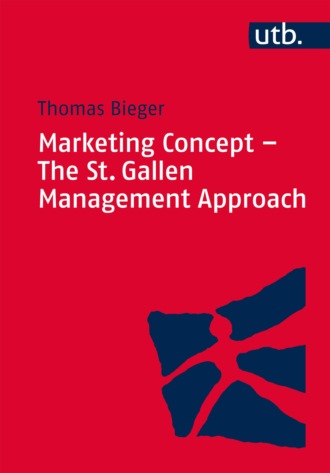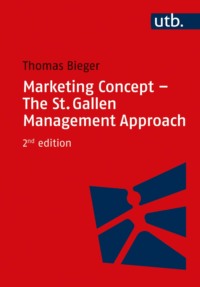
Полная версия
Marketing Concept - The St. Gallen Management Approach


Eine Arbeitsgemeinschaft der Verlage
Böhlau Verlag • Wien • Köln • Weimar
Verlag Barbara Budrich • Opladen • Toronto
facultas • Wien
Wilhelm Fink • Paderborn
A. Francke Verlag • Tübingen
Haupt Verlag • Bern
Verlag Julius Klinkhardt • Bad Heilbrunn
Mohr Siebeck • Tübingen
Nomos Verlagsgesellschaft • Baden-Baden
Ernst Reinhardt Verlag • München • Basel
Ferdinand Schöningh • Paderborn
Eugen Ulmer Verlag • Stuttgart
UVK Verlagsgesellschaft • Konstanz, mit UVK/Lucius • München
Vandenhoeck & Ruprecht • Göttingen • Bristol
Waxmann • Münster • New York
[2][3]Thomas Bieger
Marketing Concept – The St. Gallen Management Approach
Haupt Verlag
[4]Prof. Dr. Thomas Bieger is a full professor of Business Administration specializing in Tourism since 1999 and director of the Institute for Systemic Management and Public Governance at the University of St. Gallen. He was Secretary General of the AIEST (International Association of Scientific Experts in Tourism), and he is the chairman of CEMS (Global Alliance in Management Education). He held several guest Professorships at the University of Innsbruck and the Vienna University of Economics and Business. He also taught at the Simon Fraser University, Vancouver, at the Università della Svizzera italiana in Lugano and as William Fraser Fellow at the University of Otago, Dunedin/New Zealand. From 2003 until 2005 he served as a Dean of the Faculty of Management at the University of St. Gallen. From 2005 until 2010 he was Vice President, since February 1st 2011 he is President of the University of St. Gallen.
1st edition: 2015
Bibliographic information published by Die Deutsche Nationalbibliothek
Die Deutsche Nationalbibliothek lists this publication in the Deutsche Nationalbibliografie; detailed bibliographic data is available on the internet at http://dnb.dnb.de
All Rights reserved.
Copyright © 2015 Haupt
This book, including all of its parts, is protected by copyright. Every kind of use beyond the limits of the narrow restrictions of the law of copyright is not allowed without the explicit consent of the editor. Noncompliance to this restrictions are inadmissible and criminal. This applies equally for the duplication, translation, microfilming as well as for digital storage and subsequent processing of the book or any of its parts.
Layout: René Tschirren
Einbandgestaltung: Atelier Reichert, Stuttgart
www.haupt.ch
UTB number: 4464
ISBN 978-3-8252-4464-4
eBook-Herstellung und Auslieferung:
Brockhaus Commission, Kornwestheim
www.brocom.de
[5]Preface
The St. Gallen Management Model created a comprehensive orientation framework for the management of companies and organizations of all kinds. Business processes play a special role in the model. They enable the real core function that justifies the existence of a company or organization, which is to deliver goods and services to third parties, usually for money.
This book is guided by the St. Gallen Management Model and, therefore, focuses on business processes. It also follows the approach of the marketing concept as an overall planning-and-designing approach, not just for marketing, but for all business functions. The content of this book thus offers an introduction to marketing as well as the design of business processes as a whole.
The book addresses two targets and thus two target groups: To begin with, it serves as a basis for the introduction to business administration as part of the Marketing Management curriculum during the Assessment Year at the University of St. Gallen. It covers the subject areas of marketing, performance and innovation.
At the same time, it is designed to appeal to the public at large as a basic text for study or practice. It serves as an introduction to or an update of knowledge in the areas of marketing and performance/performance process, while also presenting the marketing concept as a pragmatic thought-and-action approach used by generations of (marketing) managers.
The outline of the book follows the usual structure of a marketing concept and is also the basis for the division into six lecture blocks at the University of St. Gallen:
1.Business Processes and Marketing Concept within the St. Gallen Management Model — an Introduction2.Market Analysis — from a Static to a Dynamic Point of View3.Marketing Strategy — from Market Segmentation to Positioning Strategy4.[6] Marketing Tool Application 1: Product Design and Performance5.Marketing Tool Application 2: Pricing, Promotion and Distribution6.Innovation and Controlling — Meta Processes of Business ActivityAs a topical guide for decision makers and as teaching material on a university level, the book’s aim is not maximum depth and the transfer of detailed knowledge. Rather, the goal is contextual knowledge and new perspectives in thinking. As a textbook, it primarily points out the key sources.
At the same time, the integrative approach cultivated at the University of St. Gallen will be taken into account. This results from a focus on the St. Gallen Management Model as well as from methodically including the approach of networked thinking in the market-analysis section and by cross-referencing other disciplines, especially economics and law.
In part, this book is based on principles, concepts and text blocks of the book “Einführung in die Managementlehre” by Dubs, Euler, Rüegg-Stürm and Wyss (2009), which was used previously as a textbook at the University of St. Gallen and to which the author also contributed. The following authors also worked on the previous book in the area of business processes: Günther Schuh, Thomas Friedli, Torsten Tomczak, Fritz Fahrni and Sven Reinecke.
I want to thank Mrs. Margareta Brugger for transcribing the manuscript, student assistant Jessica Schulten-Baumer for revising and editing the text, and my wife Barbara for critical reading. I also thank Samuel Heer for his valuable support, not only in revising this book but also in our efforts to offer actual and method-oriented lectures on the assessment level of the University of St. Gallen. I also thank my colleagues o. Univ. Prof. Dr. Johannes Rüegg-Stürm and assistant professor Dr. Simon Grand for stimulating discussions, the good cooperation, and many valuable inputs.
May 2015Thomas Bieger[7]Contents
Preface
Table of Figures
1Business processes and marketing concept within the St. Gallen Management Model — an introduction1.1Case study LÄDERACH1.2Value-creation processes, companies and management1.3Embedding business processes into the St. Gallen Management Model1.3.1Stakeholders1.3.2Environmental spheres1.3.3Environments and sustainability1.3.4Horizons of meaning1.3.5Business processes within the St. Gallen Management Model1.4Objectives of business processes1.5Structure of business processes1.5.1Performance processes1.5.2Customer processes1.5.3Innovation processes1.6The marketing approach for the management of business processes1.6.1Development of marketing6.1.2Marketing concept2Market analysis as the basis for market-oriented business management2.1Case study MAMMUT2.2Customer behavior and markets2.2.1Definition and role of markets2.2.2Players and market types[8]2.2.3Motives, needs, benefit and demand2.3Market research objectives and data generation2.3.1Identifying market sizes, needs and decision-making2.3.2Supply-and-demand trends2.4SWOT analysis as a synthesis of market analysis3Marketing strategy — from market segmentation to a positioning strategy3.1Case study JURA3.2Marketing objectives3.2.1Corporate objectives and marketing objectives3.2.2Interaction of marketing objectives3.3From market segmentation to a positioning strategy3.3.1Segmentation criteria and segmentation level3.3.2Choice of target market3.3.3Positioning3.4From customer processes to tool strategy3.4.1Determinants of tool application3.4.2Focus on marketing tool application in the marketing mix4Product design and performance4.1Case study STADLER RAIL AG4.2Product design4.3Performance provision — physical product4.3.1Basic structure of the performance process4.3.2Strategic decisions4.3.3Operational decisions4.4Performance provision — services4.4.1Characteristic features of services4.4.2Performance design and control of the service process4.4.3From service chain to service blueprint5Marketing tool application5.1Case study JUNGFRAUBAHN5.2Pricing policy5.2.1Neoclassic pricing model5.2.2Behavioral-science pricing models5.2.3Functions of pricing[9]5.3Distribution policy5.3.1Functions of distribution5.3.2Distribution design5.4Communication5.4.1Role and function of communication5.4.2Organizational scopes of communication5.4.3Communication change5.5Marketing mix5.5.1Objectives of the marketing mix5.5.2Planning the marketing mix6Controlling and innovation6.1Case study SWISS web portal6.2Marketing controlling6.2.1Development of a controlling concept6.2.2Characteristics of marketing controlling6.2.3Contribution accounting6.3Innovation6.3.1Functions, roles and tools of innovation6.3.2Return on innovation6.3.3Innovation in models6.3.4Innovation’s directions of impactBibliography
Alphabetical index
[10][11]Table of Figures
Fig. 1:Example of a value chainFig. 2:Value-creation network and meta-systemFig. 3:Transaction interface and companyFig. 4:Management cycle according to FayolFig. 5:4th generation of the St. Gallen Management ModelFig. 6:Stakeholders of a companyFig. 7:St Galler Management model with environmental spheresFig. 8:Triple bottom lineFig. 9:Contents of the three horizons of meaningFig. 10:Primary processes or business processes, according to PorterFig. 11:Business processes and marketsFig. 12:Perceived customer valueFig. 13:Conceptual relation between customer value, added value and company valueFig. 14:Calculation of added valueFig. 15:Structure of business processesFig. 16:Performance process as an added-value chainFig. 17:Business process: goods and servicesFig. 18:Service chain in incoming tourismFig. 19:The customer buying cycleFig. 20:Brand equity according to Interbrand — the ten most valuable brands in 2014Fig. 21:Five-phase product life-cycle modelFig. 22:Possible roles of companies in a value chainFig. 23:Development of marketingFig. 24:Marketing conceptFig. 25:Customer systemFig. 26:Benefits of long-term customer commitmentFig. 27:Transaction relationships in e-commerceFig. 28:Composition of demandFig. 29:Purchase decision for holiday travels[12]Fig. 30:SOR behavioral modelFig. 31:Theory of planned behaviorFig. 32:Market sizesFig. 33:Importance of specific information sources in tourismFig. 34:Travel motivation (1+ overnights)Fig. 35:Types of trendsFig. 36:Development of trendsFig. 37:Systematic analysis of new trends using the example of scootersFig. 38:Example of a simplified tourism system and its dynamicsFig. 39:Market analysis as part of the marketing conceptFig. 40:Matrix of a SWOT analysisFig. 41:Strength and weakness analysis of a typical Swiss destinationFig. 42:Demand trends and opportunities and threats deduced from them for a Swiss destinationFig. 43:Marketing strategy within the marketing conceptFig. 44:Goal hierarchy in marketing (exemplary)Fig. 45:From market segmentation to differentiationFig. 46:Optimal segmentationFig. 47:Multi-stage market segmentation for the skiing marketFig. 48:Statistical market segmentation by motives with the help of cluster analysesFig. 49:Ways of illustrating brand positioningFig. 50:Industry environment conditions and basic strategies for customer acquisitionFig. 51:Why customer retention pays offFig. 52:Customer retention’s main tasksFig. 53:Overview of marketing toolsFig. 54:Detailed planning of a marketing mix — marketing planFig. 55:From customer value to value of the customerFig. 56:Conception levels for the productFig. 57:Goods and services typologyFig. 58:Alternative decisions depending on program policyFig. 59:Basic structure of the physical performance processFig. 60:Basic structure of performance processFig. 61:Conflicting priorities of strategic management in the vertical business areaFig. 62:Types of businessFig. 63:Characteristic features of servicesFig. 64:Demarcation between service and material good[13]Fig. 65:Service chain in incoming tourism — destination point of viewFig. 66:Individual service chainFig. 67:Service chain in outgoing tourism — perspective travel as a whole and travel agencyFig. 68:Concept of a service chain from a customer’s perspectiveFig. 69:Demand curve as an aggregation of individual preferencesFig. 70:Price effect elasticitiesFig. 71:Assimilation contrast theoryFig. 72:Price determinationFig. 73:Yield management systemsFig. 74:Yield management for booking systemsFig. 75:Strategic distributionFig. 76:Example: Sales channel in tourismFig. 77:Distribution systemFig. 78:Development prospects in distributionFig. 79:General communication process and marketing communication processFig. 80:Communication organizationFig. 81:Communication toolsFig. 82:Examples for tool goals in marketingFig. 83:Detailed planning marketing mix — marketing planFig. 84:Marketing mix within the buying cycleFig. 85:Management function according to FayolFig. 86:Possible indicators for measuring marketing’s success during a relaunchFig. 87:Goal hierarchy and controllingFig. 88:Product-specific multi-level contribution-accounting analysisFig. 89:SWISS INTERNATIONAL AIR LINES controlling structureFig. 90:Return on investment between the poles of innovation push and pullFig. 91:The innovation processFig. 92:Required innovation according to industry and goodsFig. 93:Innovation cube for the classification of strategic directions of impactFig. 94:Marketing conceptКонец ознакомительного фрагмента.
Текст предоставлен ООО «ЛитРес».
Прочитайте эту книгу целиком, купив полную легальную версию на ЛитРес.
Безопасно оплатить книгу можно банковской картой Visa, MasterCard, Maestro, со счета мобильного телефона, с платежного терминала, в салоне МТС или Связной, через PayPal, WebMoney, Яндекс.Деньги, QIWI Кошелек, бонусными картами или другим удобным Вам способом.


